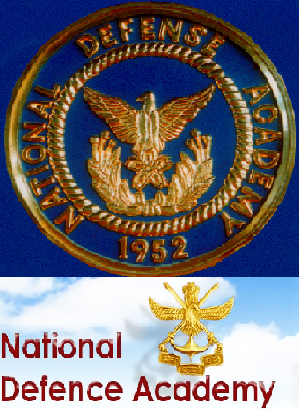Table of Contents
National Defence Academy NDA Exam Pattern & Syllabus
Union Public Service Commission is going to conduct the National Defense Academy and naval Academy examination with the purpose to recruit most eligible candidates in Army, Navy and Air Force. Those who have ambition to enhance their career in defense sector have to qualify the exam.
Thousands of applicants appears in this UPSC NDA I Exam & UPSC NDA 2 Exam and got selected on the basis of their skills. Aspirants, who want to grab the respective job opportunity this time must be, prepare themselves in a way, so that they can easily qualify the NDA Examination. This may be possible if one practice according to the NDA Syllabus 2017–2018.
If candidates give their full concentration on each and every topic, they get the confidence to attend the exam in the proper and correct way and they can qualify the National Defence Academy and Naval Academy Examination with good cut off marks.
NDA Exam Details 2017
- The Written Exam consists of two objective type papers
- The first paper is of Mathematics (300 Marks)
- The second one is of General Ability (600 Marks)
- This exam is conducted by UPSC.
- Exam will be organized in the duration of 2.5 hours.
- Candidates, who will qualify NDA NA Exam, will be called
- For SSB Test/ Interview, which will contain 900 marks.
NDA Pattern for Exam
| Paper | Number of Questions | Time | Marks |
| Paper I: Mathematics | 120 | 2.5 Hours | 300 |
| Paper II: English & General Ability | 150 | 2.5 Hours | 600 |
| Total | 270 | 5 Hours | 900 |
Syllabus for NDA 2017
The Mathematics Section of NDA Syllabus consists the following topics:
| Algebra: | Statistics and Probability: |
| · Concept of set, operations on sets, Venn diagrams
· De Morgan laws · Cartesian product, relation, equivalence relation · Representation of real numbers on a line · Complex numbers – basic properties, modulus, argument and cube roots of unity · Binary system of numbers · Conversion of a number in decimal system to binary system and vice-versa · Arithmetic, Geometric and Harmonic progressions · Quadratic equations with real coefficients · Solution of linear in equations of two variables by graphs · Permutation and Combination · Binomial theorem and its application · Logarithms and their applications. |
Statistics:
· Classification of data, Frequency distribution, cumulative frequency distribution – examples · Graphical representation – Histogram, Pie Chart, Frequency Polygon – examples · Measures of Central tendency – Mean, Median and Mode · Variance and standard deviation – determination and comparison · Correlation and regression Probability: · Random experiment, outcomes and associated sample space, events, mutually exclusive and exhaustive events, impossible and certain events · Union and Intersection of events. Complementary, elementary and composite events · Definition of probability – classical and statistical – examples · Elementary theorems on probability – simple problems · Conditional probability, Bayes’ theorem – simple problems · Random variable as function on a sample space · Binomial distribution, examples of random experiments giving rise to Binominal distribution |
| Matrices and Determinants: | Vector Algebra: |
| · Types of matrices, operations on matrices
· Determinant of a matrix, basic properties of determinants · Adjoint and inverse of a square matrix · Applications – Solution of a system of linear equations in two or three unknowns by Cramer’s rule and by Matrix Method. |
· Vectors in two and three dimensions, magnitude and direction of a vector
· Unit and null vectors, addition of vectors, scalar multiplication of vector, scalar product or dot product of two-vectors · Vector product and cross product of two vectors · Applications-work done by a force and moment of a force, and in geometrical problems |
| Differential Calculus: | Integral Calculus and Differential Equations: |
| · Concept of a real valued function – domain, range and graph of a function
· Composite functions, one to one, onto and inverse functions · Notion of limit, Standard limits – examples · Continuity of functions – examples, algebraic operations on continuous functions · Derivative of function at a point, geometrical and physical interpretation of a derivative – applications · Derivatives of sum, product and quotient of functions, derivative of a function with respect of another function, derivative of a composite function · Second order derivatives. Increasing and decreasing functions · Application of derivatives in problems of maxima and minima |
· Integration as inverse of differentiation, integration by substitution and by parts, standard integrals involving algebraic expressions, trigonometric, exponential and hyperbolic functions
· Evaluation of definite integrals – determination of areas of plane regions bounded by curves – applications · Definition of order and degree of a differential equation, formation of a differential equation by examples · General and particular solution of a differential equation, solution of first order and first degree differential equations of various types – examples · Application in problems of growth and decay |
| Trigonometry: | Analytical Geometry of two and three dimensions: |
| · Angles and their measures in degrees and in radians
· Trigonometrical ratios · Trigonometric identities Sum and difference formulae · Multiple and Sub-multiple angles · Inverse trigonometric functions. Applications – Height and distance, properties of triangles |
· Rectangular Cartesian Coordinate system
· Distance formula · Equation of a line in various forms · Angle between two lines · Distance of a point from a line · Equation of a circle in standard and in general form · Standard forms of parabola, ellipse and hyperbola · Eccentricity and axis of a conic · Point in a three dimensional space, distance between two points · Direction Cosines and direction ratios · Equation of a plane and a line in various forms · Angle between two lines and angle between two planes · Equation of a sphere |
UPSC NDA NA Exam Pattern for Paper 1
| Paper | Subject | Total Marks |
| Mathematics | Algebra | 300 |
| Matrices and Determination | ||
| Trigonometry | ||
| Analytical Geometry | ||
| Differential Calculus | ||
| Integral Calculus and Differential Equations | ||
| Vector Algebra | ||
| Statistics and Probability |
After the candidate qualifies the written test he/she will be called for the next level of testing i.e. interview test , on the basis of that interview test the mind of the candidate is judged.
Interview Test :
- The Union Public Service Commission will declare a qualified list of candidates (based on the written exam).
- The selected candidates will appear before a Services Selection Board for Intelligence and Personality Test.
- Candidates for the Army/Navy wings of the NDA and Executive branch of Naval Academy will be assessed on officers potentiality
- Candidates for the Air Force wing, along with officer potentiality assessment, will also undergo a Pilot Aptitude Test.
After this Qualified candidates will then be placed in the final order of merit on the basis of total marks secured by them in the Written examination, and the Services Selection Board Tests in three separate lists:
Army and the Navy,
Air Force
Executive course at the Naval Academy.
The names of candidates who qualify for all the Services of NDA and the Naval Academy will appear in all the three Merit Lists.
The final selection for admission will be made in order of merit depending on the number of vacancies in each wing.
Thus in order to seek career in NDA 2017 ONE SHOULD DO HARD LABOUR, if you are positive and your determination level is high then you can crack it easily. Everything depends upon you how you take it and how you leave it.
Visit Current-Affairs.org for the current affairs, previous year question papers, online quiz for the competitive exams and many more. If you need more question paper comment down your email id.




